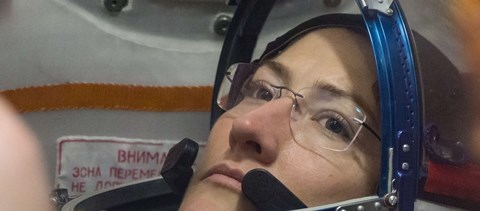Array
(
[count_posts] => 1
[cache_key] => Query_Posts::global::hu::YTo1OntzOjQ6ImxhbmciO3M6MjoiaHUiO3M6NzoiZG9tYWlucyI7YToxOntpOjA7czo0OiJsaWZlIjt9czo2OiJvZmZzZXQiO2k6MDtzOjk6InRheF9xdWVyeSI7YToxOntpOjA7YTozOntzOjg6InRheG9ub215IjtzOjg6InBvc3RfdGFnIjtzOjU6ImZpZWxkIjtzOjI6ImlkIjtzOjU6InRlcm1zIjthOjE6e2k6MDtpOjIxODY7fX19czoxMToiYWZ0ZXJMb2NrZXIiO2k6MDt9
[has_result] => 1
[posts] => Array
(
[0] => Array
(
[id] => 4302
[content] =>

Christina Koch alig töltött kevesebb napot a Nemzetközi Űrállomás (ISS) fedélzetén, mint az amerikai rekorder Scott Kelly. Kazahsztánban ért Földet két társával. 328 nap. Pontosan ennyit töltött a világűrben – a Nemzetközi Űrállomás fedélzetén – a NASA űrhajósa, Christina Koch, aki küldetése során több rekordot is felállított. Koch csütörtökön ért Földet, a visszatérés sikeres volt.
Koch a maga 328 napos küldetésével a második legtöbb időt az űrben töltő űrhajóssá vált. Őt csak Scott Kelly előzi meg az amerikaiak között, aki 2015-16-ban összesen 340 napig tartózkodott a Nemzetközi Űrállomáson. A nők között viszont övé az elsőség, a korábbi rekorder a szintén a NASA kötelékében szolgáló Peggy Whitson volt, aki 2017-ben 289 napot húzott le az ISS-en.
Koch nevéhez azonban nemcsak ez a rekord fűződik: Jessica Meir űrhajóssal közösen ők hajtották végre az első olyan űrsétát, amelyben csak nők vettek részt. Az októberi küldetés során az állomás akkumulátorait cserélték ki.
Koch az európai Luca Parmitanóval – aki nemrég megsütötte az első csokis kekszet az űrben –, valamint az orosz Alexander Szkvorcovval együtt landolt a Földön. A Szojuz MS-13 fedélzetén Kazahsztánban szálltak le, ahonnan egy orvosi létesítménybe vitték őket, hogy elvégezzék az ilyenkor szükséges vizsgálatokat és beavatkozásokat.
A NASA űrhajósa a küldetése 328 napja alatt 5248 alkalommal kerülte meg a Földet az ISS fedélzetén, amivel összesen 223,7 millió kilométert tett meg. Ebből nagyjából 291-szer jönne ki a Föld-Hold-Föld utazás. Munkája során több mint 210 kísérletet végzett el, miközben ő maga is kísérlet volt, a NASA ugyanis megfigyelte, miként reagál a szervezet, ha sokáig van az űrben.
SpaceX is building floating, superheavy-class spaceports for Mars, moon & hypersonic travel around Earth https://t.co/zLJjz43hKw
— Elon Musk (@elonmusk) June 16, 2020
[_oembed_time_5a3f341fa3d000f2b50d698c48c64d13] => 1593208080
[_oembed_be41a6b151027fd40a71dd9df58be85e] =>
[_oembed_time_be41a6b151027fd40a71dd9df58be85e] => 1593208080
[_oembed_7eea109c46813c16120b3cb489a6c407] => Please tell me we can still get close enough to see them launch. It’ll be such a shame if there can’t be a giant crowd gathered to witness history ? pic.twitter.com/0io1cC4yk2
— Everyday Astronaut (@Erdayastronaut) June 16, 2020
[_oembed_time_7eea109c46813c16120b3cb489a6c407] => 1593208081
[_oembed_802ba214cf74c16af58dea70ba331c57] => What's the current target for the first Earth to Earth flights?
— Viv ? (@flcnhvy) June 16, 2020
[_oembed_time_802ba214cf74c16af58dea70ba331c57] => 1593208081
[_oembed_c012754b540ea8610472b53342192e18] =>
[_oembed_time_c012754b540ea8610472b53342192e18] => 1595066774
[_oembed_bccd5506cb11f48ed3543a74395c45c0] => {{unknown}}
[_oembed_50111c22f4aabad9dc04ea2791a6f8fc] =>
[_oembed_time_50111c22f4aabad9dc04ea2791a6f8fc] => 1597249080
[_oembed_c6a6977a3746f053ec0bcca946fabf9b] =>
[_oembed_time_c6a6977a3746f053ec0bcca946fabf9b] => 1597249081
[_oembed_ab9406c3e7d88210bd6e3430aa54b580] =>
[_oembed_time_ab9406c3e7d88210bd6e3430aa54b580] => 1610436937
[_oembed_889c10879d516d9338910ef37fe5199c] =>
[_oembed_time_889c10879d516d9338910ef37fe5199c] => 1615178801
[_oembed_20ce5ecb79e31c6e14d8a9c485b3cd67] =>
[_oembed_time_20ce5ecb79e31c6e14d8a9c485b3cd67] => 1622014353
[_oembed_69c7a6f3422bc2baabcc41024424858a] => China National Space Administration releases latest high-definition Mars images taken and sent back by #Zhurong, the country's first Mars rover. #Tianwen1 #Tianwen #祝融 #天问 pic.twitter.com/64wVWYs8jF
— WatchTower (@WatchTowerGW) June 11, 2021
[_oembed_time_69c7a6f3422bc2baabcc41024424858a] => 1624212728
[_oembed_7c07626aad80315cbfe968a9319c2b22] => Oh, this is amazing. Close to tears. Ourspace has published an update on the "mystery hut" and it's so underwhelming it's brilliant. It's just a small rock on a crater rim that they're now calling "jade rabbit" for its appearance. Source: https://t.co/frrMKH7RWM https://t.co/GFCIRzqmDu pic.twitter.com/jpDLDS8TZu
— Andrew Jones (@AJ_FI) January 7, 2022
[_oembed_time_7c07626aad80315cbfe968a9319c2b22] => 1642602064
[_oembed_7338a46efbfb0e136e60f4f5efdf5dac] => ? Hello, #Starliner! @BoeingSpace's human-rated spacecraft has arrived at the International @Space_Station for the first time, docking at 8:28pm ET (00:28 UTC). pic.twitter.com/gXceiHJhuB
— NASA (@NASA) May 21, 2022
[_oembed_time_7338a46efbfb0e136e60f4f5efdf5dac] => 1654368597
[_oembed_8507a802bcd8a211015f165011b0bff8] =>
[_oembed_time_8507a802bcd8a211015f165011b0bff8] => 1665223881
[_oembed_699a9949b6c91160e850e493e8805212] => Teams at @NASAKennedy have assessed impacts from Hurricane Ian & determined there was no damage to #Artemis I flight hardware.
@NASA will focus on the Nov. 12-27 launch period to give employees time for post-storm recovery & identify checkouts for launch https://t.co/bjDiRgnOvt pic.twitter.com/7nK2tKVDOR
— NASA Artemis (@NASAArtemis) September 30, 2022
[_oembed_time_699a9949b6c91160e850e493e8805212] => 1668927791
[_oembed_41753a0d6302dd74e6569aab6aaedf09] => Orion's Optical Navigation Camera captured these stunning views of the lunar surface during our flyby on #Artemis flight day 20. pic.twitter.com/mfTL5ZSPSp
— Orion Spacecraft (@NASA_Orion) December 7, 2022
[_oembed_time_41753a0d6302dd74e6569aab6aaedf09] => 1672180789
[_oembed_c67e1c0263f09077c80d9fc457c0feca] => The imagery we continue to get out of @NASA_Orion's onboard cameras is outstanding. Downlinked the lunar fly-by photos yesterday, and they are incredible - a few of my favorites below. Visit https://t.co/ZrjE1SVAWC to see the rest. pic.twitter.com/5KXDF3PsLq
— Jim Free (@JimFree) December 7, 2022
[_oembed_time_c67e1c0263f09077c80d9fc457c0feca] => 1672180789
[_oembed_30289a69c4d7f7f6ef6d4ffb3c78045a] =>
[_oembed_time_30289a69c4d7f7f6ef6d4ffb3c78045a] => 1673691431
[_oembed_c83cdc68b8594ac42423c3625f50d353] =>
[_oembed_time_c83cdc68b8594ac42423c3625f50d353] => 1673691432
[_oembed_b17ac91756745e69382f928dd2bb3301] => Splashdown!#Crew5 is back on Earth, completing a science mission of nearly six months on the @Space_Station. Their @SpaceX Dragon Endurance spacecraft touched down at 9:02pm ET (0202 UTC March 12) near Tampa off the coast of Florida. pic.twitter.com/nLMC0hbKY4
— NASA (@NASA) March 12, 2023
[_oembed_time_b17ac91756745e69382f928dd2bb3301] => 1680436805
[_oembed_3a3b4b728bce09709458b7df793900f0] => We've been tracking a new asteroid named 2023 DW that has a very small chance of impacting Earth in 2046. Often when new objects are first discovered, it takes several weeks of data to reduce the uncertainties and adequately predict their orbits years into the future. (1/2) pic.twitter.com/SaLC0AUSdP
— NASA Asteroid Watch (@AsteroidWatch) March 7, 2023
[_oembed_time_3a3b4b728bce09709458b7df793900f0] => 1680436805
[_oembed_57590107d0d3da5f85a713767ccf2dba] =>
[_oembed_time_57590107d0d3da5f85a713767ccf2dba] => 1681581392
[_oembed_e02ac65f153a9de93cbee9bc2534027d] =>
[_oembed_time_e02ac65f153a9de93cbee9bc2534027d] => 1687861513
[_oembed_91a0f70038b4fabcb8baed4a6ba6c210] =>
[_oembed_time_91a0f70038b4fabcb8baed4a6ba6c210] => 1703920230
[_oembed_14b1e1b6e4a236b4ff4ed4943ee02393] => Japan's 'Moon Sniper' probe attempts historic soft-landing on lunar surface. But did it make it? https://t.co/gOXn5EHViM pic.twitter.com/nubTr6hXg6
— SPACE.com (@SPACEdotcom) January 19, 2024
[_oembed_time_14b1e1b6e4a236b4ff4ed4943ee02393] => 1706539397
[_oembed_3d7e63d625b87d7786a8690ae29ddd1c] =>
[_oembed_time_3d7e63d625b87d7786a8690ae29ddd1c] => 1714660844
[_oembed_090f074d6eefc6a6e6129eaa79680343] => {{unknown}}
[_oembed_a6ab6d20f238ce9f0c2d6eeee37a35a4] =>
[_oembed_time_a6ab6d20f238ce9f0c2d6eeee37a35a4] => 1720114265
[_oembed_fe4db60f7a6fafd99783aee7b80d4da0] => Japan's 'Moon Sniper' probe attempts historic soft-landing on lunar surface. But did it make it? https://t.co/gOXn5EHViM pic.twitter.com/nubTr6hXg6
— SPACE.com (@SPACEdotcom) January 19, 2024
[_oembed_time_fe4db60f7a6fafd99783aee7b80d4da0] => 1720114265
[_oembed_f9ae9abb0d4fce11c520b492a5fcd1c5] => NASA just released the clearest view of Mars ever. (sound of Mars)
pic.twitter.com/XNIYJ0f15R
— Science (@ScienceGuys_) June 17, 2024
[_oembed_time_f9ae9abb0d4fce11c520b492a5fcd1c5] => 1721742124
[_oembed_440574682d7908d345f472dfaf912003] => Falcon 9 launches 21 @Starlink satellites to low-Earth orbit from Florida pic.twitter.com/PoDEjGYGSM
— SpaceX (@SpaceX) August 28, 2024
[_oembed_time_440574682d7908d345f472dfaf912003] => 1726394955
[_oembed_c559bf7eb89b1e09c09c39578407027e] =>
[_oembed_time_c559bf7eb89b1e09c09c39578407027e] => 1730490377
[_oembed_399ad795235db89e01f77babb17efbf2] =>
[_oembed_time_399ad795235db89e01f77babb17efbf2] => 1730490377
[_oembed_a8ad8e6880668d1ae3c623a91c07b3f7] =>
[_oembed_time_a8ad8e6880668d1ae3c623a91c07b3f7] => 1736062080
[_algolia_sync] => 508006514000
[_oembed_49f4185d315233c75548f2d327f4df59] =>
[_oembed_time_49f4185d315233c75548f2d327f4df59] => 1745906004
[_oembed_273975bb088f4d85fb50260c557daba5] => Congratulations to the @SpaceX and @NASA teams for another safe astronaut return!
Thank you to @POTUS for prioritizing this mission! https://t.co/KknFDbh59s
— Elon Musk (@elonmusk) March 18, 2025
[_oembed_time_273975bb088f4d85fb50260c557daba5] => 1745906005
[_oembed_c226e0ff99e9c4e14ba88d3cf7631dc2] => Now targeting no earlier than Wednesday, June 11 for Falcon 9 to launch @Axiom_Space's Ax-4 mission to the @Space_Station due to high winds in the ascent corridor → https://t.co/LU1wyD8uZ0 pic.twitter.com/7jygzWEUwD
— SpaceX (@SpaceX) June 9, 2025
[_oembed_time_c226e0ff99e9c4e14ba88d3cf7631dc2] => 1750692444
[_oembed_e871789c3f2ab535c1847d9761d7c988] => LIFTOFF of Axiom-4 🚀
After 41 long years, an Indian astronaut is finally on his way to space! 🇮🇳 pic.twitter.com/2KIq7IacCu
— ISRO Spaceflight (@ISROSpaceflight) June 25, 2025
[_oembed_time_e871789c3f2ab535c1847d9761d7c988] => 1752413908
[_oembed_6a740de7420fe36b1ecc47e96471c901] =>
[_oembed_time_6a740de7420fe36b1ecc47e96471c901] => 1752413908
[_oembed_402c753b18b3dfdb2df256e3512ab7fe] => Launch day is here 🚀🇵🇱
Go Axiom-4! 🔥#Ax4 #IGNIS pic.twitter.com/9UGDbtqKJT
— Sławosz Uznański-Wiśniewski (@astro_slawosz) June 25, 2025
[_oembed_time_402c753b18b3dfdb2df256e3512ab7fe] => 1752413908
[labels] => Array
(
)
[categories] => Array
(
[0] => 598
[1] => 25
[2] => 39
)
[categories_name] => Array
(
[0] => Tudomány
[1] => Videók
[2] => Világ
)
[tags] => Array
(
[0] => 2186
[1] => 2185
[2] => 2184
)
[tags_name] => Array
(
[0] => Christina Koch
[1] => NASA
[2] => Űrkutatás
)
)
)
[model] => Array
(
[lang] => hu
[offset] => 0
[tax_query] => Array
(
[0] => Array
(
[taxonomy] => post_tag
[field] => id
[terms] => Array
(
[0] => 2186
)
)
)
[afterLocker] => 0
)
[_model] => Array
(
[lang] => hu
[domains] => Array
(
[0] => life
)
[offset] => 0
[tax_query] => Array
(
[0] => Array
(
[taxonomy] => post_tag
[field] => id
[terms] => Array
(
[0] => 2186
)
)
)
[afterLocker] => 0
)
[domains] => Array
(
[0] => life
)
[_domains] => Array
(
[life] => 1
)
[status] => 1
[from_cache] =>
)







